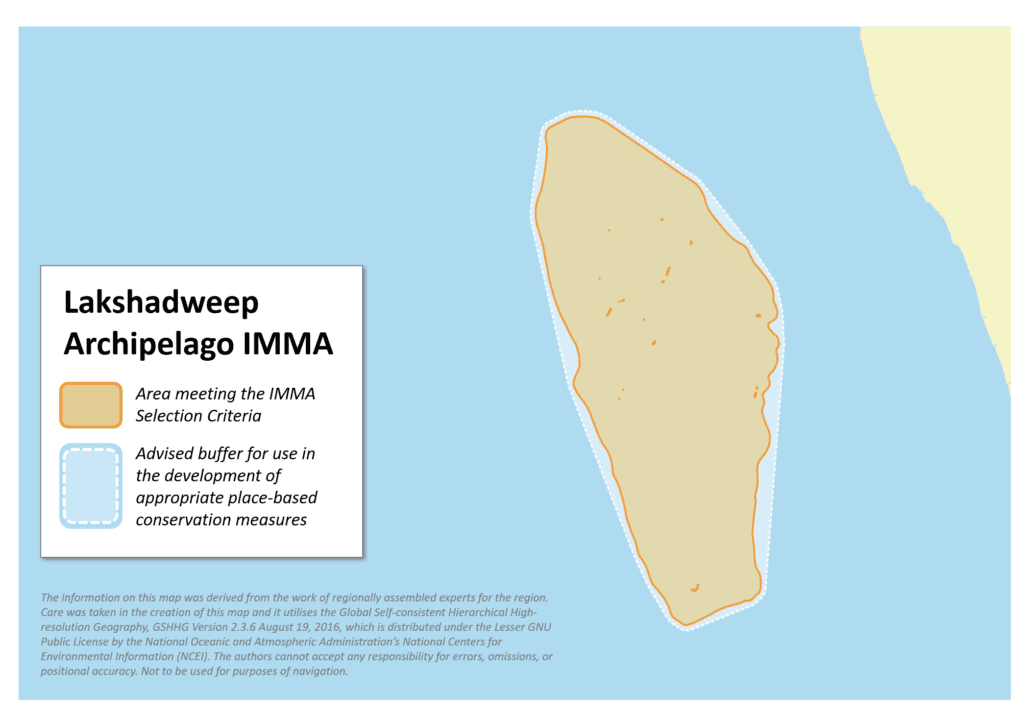Size in Square Kilometres
86,717
Qualifying Species and Criteria
Criterion D (2) – Marine Mammal Diversity
Balaenoptera musculus, Feresa attenuata, Globicephala macrorhynchus, Grampus griseus, Kogia sima, Orcinus orca, Physeter macrocephalus, Pseudorca crassidens, Stenella attenuata, Stenella coeruleoalba, Stenella longirostris, Tursiops aduncus, Tursiops truncatus, Ziphius cavirostris
Other Marine Mammal Species Documented
Summary
The Lakshadweep Archipelago is a complex of coral atolls located 220-440 km to the southwest of the Indian mainland. The area consists of diverse habitat types: coral reefs, seagrass beds, rocky and sandy shores, mangrove creeks, deep-water canyons and trenches offer a vast biodiverse landscape for cetaceans. Deep-water slopes like the ones found around Lakshadweep generate currents and upwelling of nutrients that aggregate plankton and attract a diversity of marine life. At least 14 species of cetaceans have been documented throughout the area, based on confirmed sightings, carcasses washed ashore and anecdotal information. The two most commonly observed species are Indo-Pacific bottlenose dolphins (Tursiops aduncus) and spinner dolphins (Stenella longirostris), which are present year-round inside and at the edge of the atolls. However, further research is required to determine their population status. Further research is also recommended on the possible connections between the species complexes and populations in the Maldives, which are also part of the larger Chagos-Laccadives plateau.
Description of Qualifying Criteria
Criterion A – Species or Population Vulnerability
Criterion B – Distribution and Abundance
Sub-criterion B1 – Small and Resident Populations
Sub-criterion B2 – Aggregations
Criterion C: Key Life Cycle Activities
Sub-criterion C1 – Reproductive Areas
Sub-criterion C2: Feeding Areas
Sub-criterion C3: Migration Routes
C3a – Whale Seasonal Migratory Route
C3b – Migration / Movement Area
Criterion D – Special Attributes
Sub-criterion D1 – Distinctiveness
Sub-criterion D2 – Diversity
The complex bathymetry of the area harbours at least 14 cetacean species. The shallow areas around the islands are used by spinner dolphins (Stenella longirostris) and bottlenose dolphins all throughout the year. Other cetaceans reported with confirmed sightings are Risso’s dolphins (Grampus griseus), bottlenose dolphins, striped dolphins, spinner dolphins, Cuvier’s beaked whales, dwarf sperm whales, short-finned pilot whales, sperm whales, false killer whales, pantropical spotted dolphins, pygmy killer whales, killer whales, sperm whales, as well as other unidentified baleen whales (Panicker, 2017). In dedicated research surveys over 3880.33 km of survey distance, 128 hours and 52 minutes were undertaken, resulting in 139 sightings, of which 78 were collected during survey effort and the rest were sighted off-effort (Panicker et al., in press). These areas are rich in seagrass beds used by green sea turtles, olive Ridley turtles and several species of elasmobranchs. Fisher reports suggest seasonal occurrence of large whales identified by blows that can be seen from a distance. Other sightings from the region have been taken from platforms of opportunity, therefore the diversity from this region may be an underestimate and likely biased against deep-diving, cryptic or rare species.
Supporting Information
Afsal, V. V., K. S. S. M. Yousuf, B. Anoop, A. K. Anoop, P. Kannan, M. Rajagopalan, and E. Vivekanandan. 2008. A note on cetacean distribution in the Indian EEZ and contiguous seas during 2003-07. Journal of Cetacean Research and Management 10(3): 209-216.
Kumar, KV Aneesh, Sibi T. Baby, K. V. Dhaneesh, Hashim Manjebrayakath, N. Saravanane, and M. Sudhakar. 2018. A Stranding Record of Dwarf Sperm Whale Kogia sima in Lakshadweep Archipelago, India and its Genetic Analogy by Molecular Phylogeny. Thalassa: An International Journal of Marine Sciences 1-7.
Panicker, D, Sutaria, D, Kumar, A, Stafford, K. (In Press). Cetacean Distribution and Diversity in Lakshadweep Waters, India Using a Platform of Opportunity: October 2015 to April 2016. Aquatic Mammals
Panicker, D. 2017. Cetacean Diversity and Distribution in the Lakshadweep Islands, India. Final report to Rufford Foundation for Small Grants https://www.rufford.org/files/16159-2 Final Report.pdf
Sajikumar, Kurichithara, K., Nadakkal Ragesh, and Kolliyil S. Mohamed. 2014. Behaviour of Short-finned Pilot Whales Globicephala macrorhynchus (Gray, 1846) (Mammalia: Cetartiodactyla: Delphinidae) in the southeastern Arabian Sea. Journal of Threatened Taxa. 6(11): 6488-6492.
Downloads
Download the full account of the Lakshadweep Archipelago IMMA using the Brochure button below:
To make a request to download the GIS Layer (shapefile and/or geojson) for the Lakshadweep Archipelago IMMA please complete the following Contact Form:



